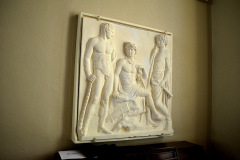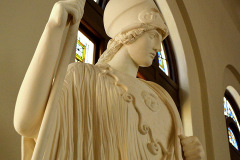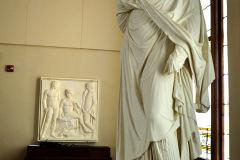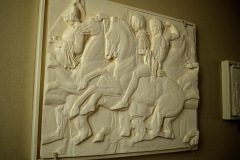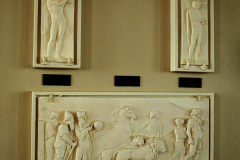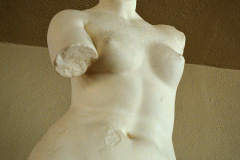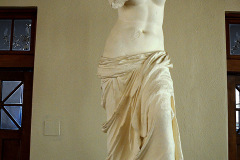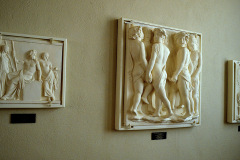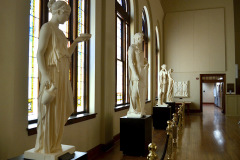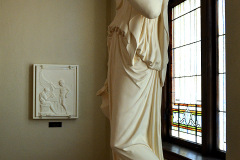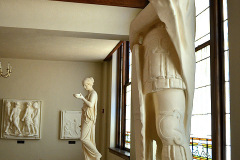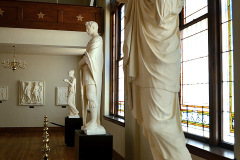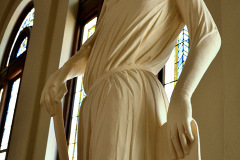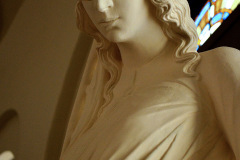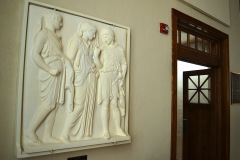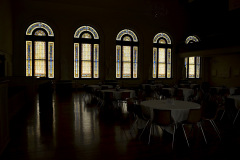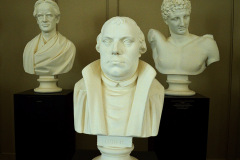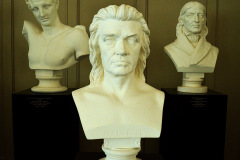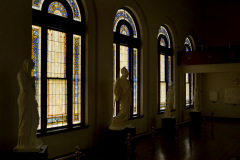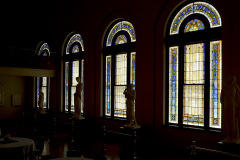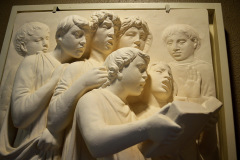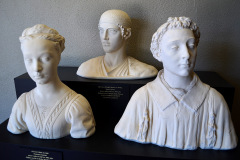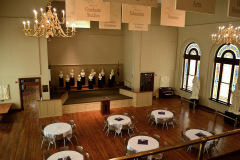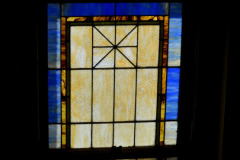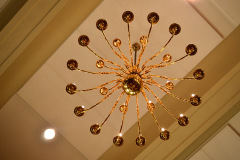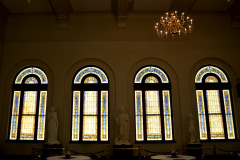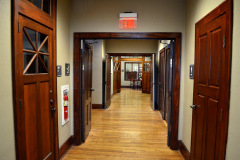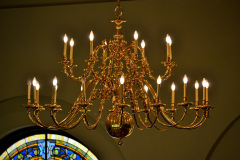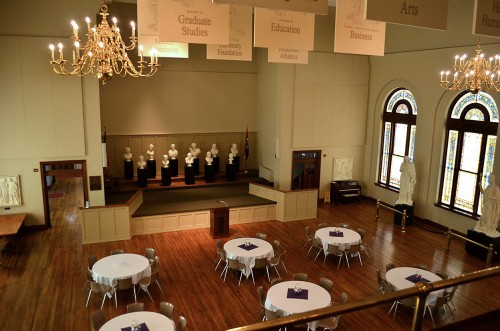 Yesterday we showed the exterior of the old First Baptist Church, now Southeast Missouri State University’s Aleen Vogel Wehking Alumni Center. Today, as promised, we’ll “go inside” to see the Barbara Hope Kem Statuary Hall, an auditorium created from the former church’s sanctuary.
Yesterday we showed the exterior of the old First Baptist Church, now Southeast Missouri State University’s Aleen Vogel Wehking Alumni Center. Today, as promised, we’ll “go inside” to see the Barbara Hope Kem Statuary Hall, an auditorium created from the former church’s sanctuary.
I thought the layout of the sanctuary area where the statues are displayed looked a little strange for a church. Two of my readers commented that was because the banks wanted to hedge their bets, so they required that the building be constructed so it could be used as a theater in case the church couldn’t pay off the loan. The balcony, Liz Lockhart wrote, even had space for a projection booth, should it ever be needed.
Plaster casts came from 1904 World’s Fair
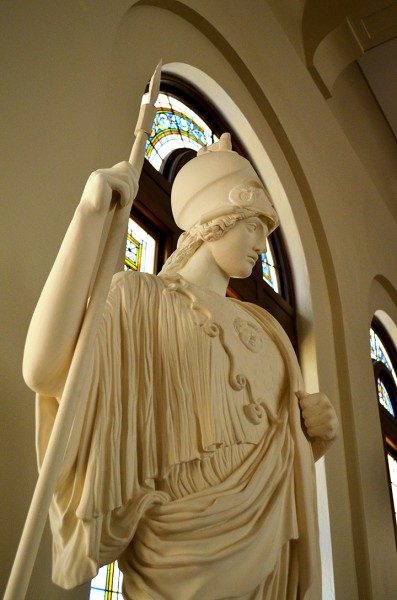 The statues and other pieces of artwork were bought by Louis Houck after he saw the August Gerber’s reproductions of classical, medieval, renaissance, and modern art works displayed at the 1904 World’s Fair in St. Louis. He acquired the casts for $1,888.25.
The statues and other pieces of artwork were bought by Louis Houck after he saw the August Gerber’s reproductions of classical, medieval, renaissance, and modern art works displayed at the 1904 World’s Fair in St. Louis. He acquired the casts for $1,888.25.
Lauren Kellogg Disalvo’s master’s thesis, THE AURA OF REPRODUCTION: PLASTER CAST COLLECTIONS AT THE 1904 LOUISIANA PURCHASE EXPOSITION, contains a large section on Houck’s purchase.
Disalvo writes that Houck’s donation of the statuary stipulated that a room be dedicated to them where they could be permanently displayed. The display opened in March of 1905 with the statues in Academic Hall.
Statues damaged and destroyed
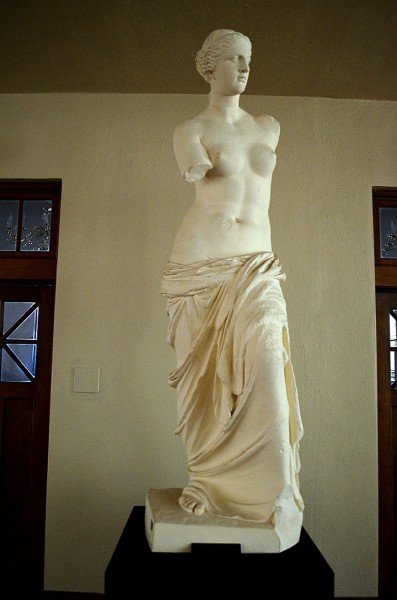 The casts remained there until 1959, when they were dispersed all over campus to make room for additional classroom space. They suffered from benign neglect over the years, with many being damaged or destroyed. One of my readers wrote that he had seen broken statues in the basement of Academic Hall when he was a student.
The casts remained there until 1959, when they were dispersed all over campus to make room for additional classroom space. They suffered from benign neglect over the years, with many being damaged or destroyed. One of my readers wrote that he had seen broken statues in the basement of Academic Hall when he was a student.
(For all I know, Venus de Milo might have had both her arms before SEMO got hold of her.)
Judy Crow takes up the cause
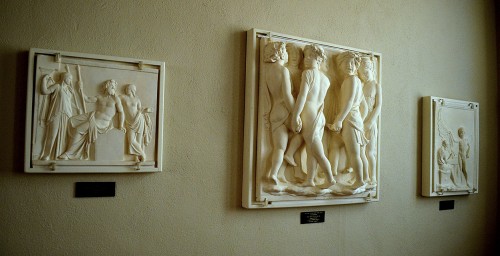 In 1975, my friend, Judy Crow, Missourian librarian, wrote a story bemoaning the fate of the Houck collection.
In 1975, my friend, Judy Crow, Missourian librarian, wrote a story bemoaning the fate of the Houck collection.
The result was, Disalvo writes, “the plaster casts were gathered, restored and transferred to the Southeast Missouri Regional Museum. The casts remained in the museum until it relocated to the new Rosemary Berkel and Harry L. Crisp II Southeast Missouri Regional Museum. According to the museum director, Dr. Stanley Grand, the plaster casts were not included in this new museum since the new museum would focus on the archaeology, history, and fine arts of the Southeast Missouri region.”
I’m not surprised that the River Campus, which knocked down the handball courts, one of the Cape’s oldest landmarks, couldn’t find room for Houck’s donation. The irony is the university probably wouldn’t be in Cape Girardeau today had Houck not used his influence to rebuild Academic Hall after the first one burned down.
Class of 1957 raised $100,000
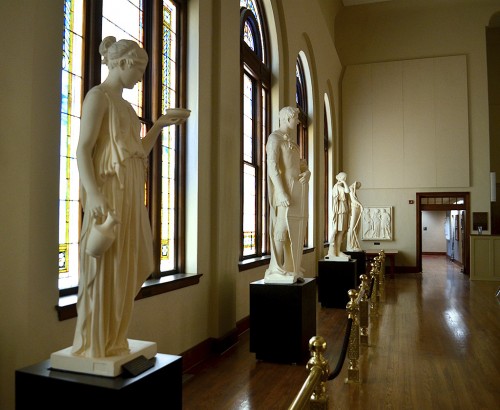 In 2007, the Class of 1957 raised $100,000 to have the remaining 38 surviving casts restored and moved to the Aleen Vogel Wehking Alumni Center, formerly the First Baptist Church, where they now line the walls of an auditorium area, called the Barbara Hope Kem Statuary Hall.
In 2007, the Class of 1957 raised $100,000 to have the remaining 38 surviving casts restored and moved to the Aleen Vogel Wehking Alumni Center, formerly the First Baptist Church, where they now line the walls of an auditorium area, called the Barbara Hope Kem Statuary Hall.
The display is open to the public. Admission is free. I think Houck would approve.
Louis Houck Statuary photo gallery
Click on any photo to make it larger, then use your arrow keys to move through the gallery.

